
A loudspeaker is an electroacoustic transducer; a device which converts an electrical audio signal into a corresponding sound. The most widely used type of speaker is the dynamic speaker. The sound source must be amplified or strengthened with an audio power amplifier before the signal is sent to the speaker.
An audiophile is a person who is enthusiastic about high-fidelity sound reproduction. An audiophile seeks to reproduce the sound of a live musical performance, typically in a room with good acoustics. It is widely agreed that reaching this goal is very difficult and that even the best-regarded recording and playback systems rarely, if ever, achieve it.
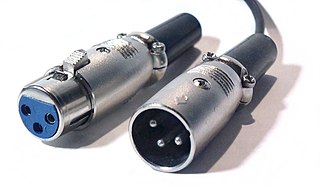
The XLR connector is a type of electrical connector primarily found on professional audio, video, and stage lighting equipment. The connectors are circular in design and have between three and seven pins. They are most commonly associated with balanced audio interconnection, including AES3 digital audio, but are also used for lighting control, low-voltage power supplies, and other applications. XLR connectors are available from a number of manufacturers and are covered by an international standard for dimensions, IEC 61076-2-103.

A preamplifier, also known as a preamp, is an electronic amplifier that converts a weak electrical signal into an output signal strong enough to be noise-tolerant and strong enough for further processing, or for sending to a power amplifier and a loudspeaker. Without this, the final signal would be noisy or distorted. They are typically used to amplify signals from analog sensors such as microphones and pickups. Because of this, the preamplifier is often placed close to the sensor to reduce the effects of noise and interference.

Monaural or monophonic sound reproduction is sound intended to be heard as if it were emanating from one position. This contrasts with stereophonic sound or stereo, which uses two separate audio channels to reproduce sound from two microphones on the right and left side, which is reproduced with two separate loudspeakers to give a sense of the direction of sound sources. In mono, only one loudspeaker is necessary, but, when played through multiple loudspeakers or headphones, identical signals are fed to each speaker, resulting in the perception of one-channel sound "imaging" in one sonic space between the speakers. Monaural recordings, like stereo ones, typically use multiple microphones fed into multiple channels on a recording console, but each channel is "panned" to the center. In the final stage, the various center-panned signal paths are usually mixed down to two identical tracks, which, because they are identical, are perceived upon playback as representing a single unified signal at a single place in the soundstage. In some cases, multitrack sources are mixed to a one-track tape, thus becoming one signal. In the mastering stage, particularly in the days of mono records, the one- or two-track mono master tape was then transferred to a one-track lathe intended to be used in the pressing of a monophonic record. Today, however, monaural recordings are usually mastered to be played on stereo and multi-track formats, yet retain their center-panned mono soundstage characteristics.
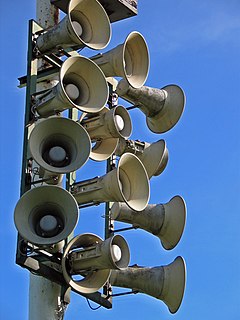
A public address system is an electronic system comprising microphones, amplifiers, loudspeakers, and related equipment. It increases the apparent volume (loudness) of a human voice, musical instrument, or other acoustic sound source or recorded sound or music. PA systems are used in any public venue that requires that an announcer, performer, etc. be sufficiently audible at a distance or over a large area. Typical applications include sports stadiums, public transportation vehicles and facilities, and live or recorded music venues and events. A PA system may include multiple microphones or other sound sources, a mixing console to combine and modify multiple sources, and multiple amplifiers and loudspeakers for louder volume or wider distribution.

In an audio system, the damping factor gives the ratio of the rated impedance of the loudspeaker to the source impedance. Only the resistive part of the loudspeaker impedance is used. The amplifier output impedance is also assumed to be totally resistive. The source impedance includes the connecting cable impedance. The load impedance and the source impedance are shown in the diagram.
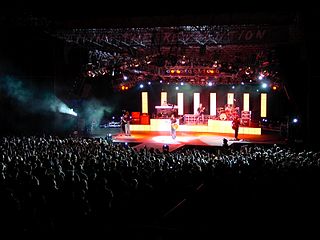
A sound reinforcement system is the combination of microphones, signal processors, amplifiers, and loudspeakers in enclosures all controlled by a mixing console that makes live or pre-recorded sounds louder and may also distribute those sounds to a larger or more distant audience. In many situations, a sound reinforcement system is also used to enhance or alter the sound of the sources on the stage, typically by using electronic effects, such as reverb, as opposed to simply amplifying the sources unaltered.

The Speakon is a trademarked name for an electrical connector, originally manufactured by Neutrik, mostly used in professional audio systems for connecting loudspeakers to amplifiers. Other manufacturers make compatible products, often under the name "speaker twist connector".

Naim Audio is a British hi-fi manufacturer based in Wiltshire, United Kingdom. The company was founded in 1973. Following a 2011 merger with French loudspeaker manufacturer Focal, Naim is owned by VerVent Audio Group, a French company.
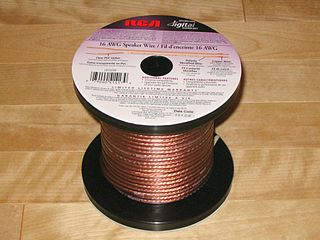
Speaker wire is used to make the electrical connection between loudspeakers and audio amplifiers. Modern speaker wire consists of two or more electrical conductors individually insulated by plastic or, less commonly, rubber. The two wires are electrically identical, but are marked to identify the correct audio signal polarity. Most commonly, speaker wire comes in the form of zip cord.

Powered speakers, also known as self-powered speakers and active speakers, are loudspeakers that have built-in amplifiers. Powered speakers are used in a range of settings, including in sound reinforcement systems, both for the main speakers facing the audience and the monitor speakers facing the performers; by DJs performing at dance events and raves; in private homes as part of hi-fi or home cinema audio systems and as computer speakers. They can be connected directly to a mixing console or other low-level audio signal source without the need for an external amplifier. Some active speakers designed for sound reinforcement system use have an onboard mixing console and microphone preamplifier, which enables microphones to be connected directly to the speaker.

Bi-wiring is a means of connecting a loudspeaker to an audio amplifier, primarily used in hi-fi systems. Normally, there is one pair of connectors on a loudspeaker and a single cable runs from the amplifier output to the terminals at the loudspeaker housing. From this point, connections are made to the loudspeaker drivers – usually through audio crossover networks.
An audio signal is a representation of sound, typically using either a changing level of electrical voltage for analog signals, or a series of binary numbers for digital signals. Audio signals have frequencies in the audio frequency range of roughly 20 to 20,000 Hz, which corresponds to the lower and upper limits of human hearing. Audio signals may be synthesized directly, or may originate at a transducer such as a microphone, musical instrument pickup, phonograph cartridge, or tape head. Loudspeakers or headphones convert an electrical audio signal back into sound.

Constant-voltage speaker systems refer to networks of loudspeakers which are connected to an audio amplifier using step-up and step-down transformers to simplify impedance calculations and to minimize power loss over the speaker cables. They are more appropriately called high-voltage audio distribution systems. The voltage is constant only in the sense that at full power, the voltage in the system does not depend on the number of speakers driven. Constant-voltage speaker systems are also commonly referred to as 25-, 70-, 70.7-, or 100-volt speaker systems; distributed speaker systems; or high-impedance speaker systems. In Canada and the US, they are most commonly referred to as 70-volt speakers. In Europe, the 100 V system is the most widespread, with amplifier and speaker products being simply labeled with 100 V.

Wireless speakers are loudspeakers that receive audio signals using radio frequency (RF) waves rather than over audio cables. The two most popular RF frequencies that support audio transmission to wireless loudspeakers include a variation of WiFi IEEE 802.11, while others depend on Bluetooth to transmit audio data to the receiving speaker.
Nominal impedance in electrical engineering and audio engineering refers to the approximate designed impedance of an electrical circuit or device. The term is applied in a number of different fields, most often being encountered in respect of:
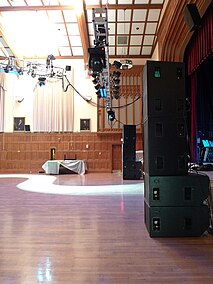
A professional audio store is a retail business that sells, and in many cases rents, sound reinforcement system equipment and PA system components used in music concerts, live shows, dance parties and speaking events. This equipment typically includes microphones, power amplifiers, electronic effects units, speaker enclosures, monitor speakers, subwoofers and audio consoles (mixers). Some professional audio stores also sell sound recording equipment, DJ equipment, lighting equipment used in nightclubs and concerts and video equipment used in events, such as video projectors and screens. Some professional audio stores rent "backline" equipment used in rock and pop shows, such as stage pianos and bass amplifiers. While professional audio stores typically focus on selling new merchandise, some stores also sell used equipment, which is often the equipment that the company has previously rented out for shows and events.
Nordost Corporation is an American high-end audio company founded in 1991 by Joe Reynolds and based in Holliston, Massachusetts. Nordost manufactures and sells audio and video cables, interconnects and unique accessories to the audiophile market and is distributed in 72 countries.















